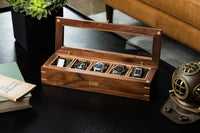There’s a well known image of Ernest Hemingway on safari with his fourth and final wife, Mary, in 1954: Seemingly adjusting his trousers, “Papa” is dressed in a fedora, tinted sunglasses, riding boots, and, of course…the requisite safari jacket.

While today the safari jacket is worn with a dab of panache by the more stylish civilians among us, its origins do indeed lie in Africa — or, more specifically, in the story of the British in Africa. During the Second Boer War from 1899-1902, British troops stationed on the continent wore khaki-colored uniforms made of cotton drill.
The uniform tops, which were thigh-length, featured four box-pleated, button-down utility pockets; a belt; and epaulets for rank and insignia — the precursor of the safari jacket. In the early 20th century, these were adopted by intrepid civilians touring Africa on safari — perhaps none so famous as ex-President Theodore Roosevelt, who spent a year in east and central Africa in 1909-1910. Roosevelt had purchased the clothing, designed by Ben Willis, at Abercrombie & Fitch.

Theodore Roosevelt (left of the American flag) during his African expedition in 1909 - notice the safari jackets and suits (Image by Smithsonian Magazine)
Hemingway would follow in 1933, dressed in a khaki “bush jacket” he commissioned from a business established in 1928 — Willis & Geiger Outfitters, founded by the aforementioned Willis and his partner William Geiger. In addition to his hunting adventures, the larger-than-life author gathered inspiration for his short stories such as The Short Happy Life of Francis Macomber and The Snows of Kilimanjaro, both considered masterpieces of short fiction.
By the time of the African campaign in the early stages of the Second World War, both British and German troops — not to mention many fashionable Italians — were wearing a variation of this garment. With its utilitarian design, functional pockets, and robust materials, it’s little surprise that it continued to be put to hard-wearing use in the field during the largest conflict in human history. (A close look at the American M1943 jacket will also reveal similar features.)
 Clark Gable and Grace Kelly in Mogambo, 1953 - (Image by The Rake)
Clark Gable and Grace Kelly in Mogambo, 1953 - (Image by The Rake)
Beginning in the 1940s, the safari jacket found itself the sartorial star of several films while draped across the shoulder of various Hollywood stars: Douglas Fairbanks Jr. wore one in Safari in 1940, while Gregory Peck threw one on as the protagonist of the film adaptation of The Snows of Kilimanjaro in 1952; finally, Clark Gable wore one in Mogambo in 1953.

Roger Moore looking dapper in a white safari jacket in 'The Man with the Golden Gun' - (Image by BAMF Style)
For some time, the safari jacket took a back seat to other garments in the sartorial zeitgeist — that is, until 1967, the year that Yves Saint Laurent offered a gabardine version in his Paris boutique, setting off a firestorm of safari jacket-themed clothing that would define 1970s style. (The trend was helped along by Roger Moore, who famously wore a white safari jacket in The Man with the Golden Gun in 1974 — as well as in three other Bond films.)

Then-Prince, now-King Charles III in a light blue safari shirt - (Image by Cosmopolitan)
Adopted by everyone from star director Francis Ford Coppola to (then-)Prince Charles throughout the 1970 and 1980s, the jacket once again largely disappeared in the 1990s and 2000s, seemingly relegated to the dustbin of sartorial history. However, it saw a revival beginning in the 2010s, with labels and retailers fashioning them out of everything from cotton drill to linen to corduroy. While certain companies refer to them as “field jackets” rather than “safari jackets,” the throughlines — the wide collar, the four pockets, the belt (or half-belt), the epaulets — are always present in some combination.
From its military origins to its adoption by civilians adventuring in Africa to its current luxurious form popular amongst the fashion set, the safari jacket is a garment whose utilitarian and handsome design has managed to endure — in one form or another — for well over a century. Though it tends to fall in and out of favor over the years, indicators are strong that its handsome, masculine appeal will see it gracing runways and appearing in closets for many years to come.
Some of Our Favorite Safari Jackets
Spier & Mackay Light Brown Tweed Field Jacket ($298)

Light Brown Tweed - Field Jacket - (Image by Spier & Mackay)
Looking for a handsome yet reasonably affordable take on the safari jacket? Start with Canadian brand Spier & Mackay. Their 100% wool Field Jacket in tweed from Abraham Moon features a handy, interior drawstring for shape and definition.
Sid Mashburn Military Jacket ($350)

Private White V.C. Linen Field Jacket 2.0 ($425)

The Linen Field Jacket 2.0 - (Image by Private White VC)
The appeal of this beautiful safari jacket is its linen construction and fine detailing: British company Private White V.C. fashioned it from stone-washed Irish linen, giving it a light but robust feel that makes it perfect for warm weather.
The Armoury by Ascot Chang Wool Herringbone Safari Jacket II ($850)

Wool Herringbone Safari Jacket II - (Image by The Armoury)
Constructed from an Italian wool herringbone, this handsome number from The Armoury hits all the right notes: With its wide collar; enlarged, gusseted waist pockets; and dual back pleats for improved freedom of movement, it’s an excellent take on a classic — in the right color, too.
Caroline Andrew Field Jacket (~$1,259)

Field Jacket (Khaki Corduroy) - (Image by Caroline Andrew)
Looking for a high-end, slightly left-of-center take on the safari jacket theme? Try the Field Jacket from London-based tailor Caroline Andrew. Available in several fabrics, the corduroy iteration is particularly fetching, and looks excellent dressed up or down in a colder setting.












